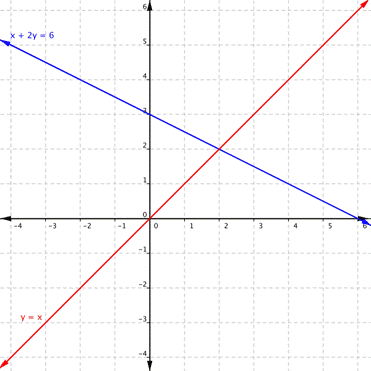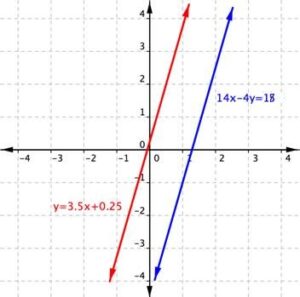section 4.1 Learning Objectives
4.1: Solving a 2×2 System of Linear Equations by Graphing
- Determine whether a given point is a solution to a system of linear equations
- Solve systems of linear equations by graphing
- Use a graph to classify solutions to systems
The way a river flows depends on many variables including how big the river is, how much water it contains, what sorts of things are floating in the river, whether or not it is raining, and so forth. If you want to best describe its flow, you must take into account these other variables. A system of linear equations can help with that.
A system of linear equations consists of two or more linear equations made up of two or more variables such that all equations in the system are considered simultaneously. You will find systems of equations in every application of mathematics. They are a useful tool for discovering and describing how behaviors or processes are interrelated. It is rare to find, for example, a pattern of traffic flow that is only affected by weather. Accidents, time of day, and major sporting events are just a few of the other variables that can affect the flow of traffic in a city. In this section, we will explore some basic principles for graphing and describing the intersection of two lines that make up a system of equations.
Solving a system of linear equations
In this module, we will look at systems of linear equations and inequalities in two variables. First, we will practice graphing two equations on the same set of axes. Later we will explore the different considerations you need to make when graphing two linear inequalities on the same set of axes. The same techniques are used to graph a system of linear equations as you have used to graph single linear equations. We can use tables of values, slope and [latex]y[/latex]-intercept, and/or [latex]x[/latex]– and [latex]y[/latex]-intercepts to graph both lines on the same set of axes.
For example, consider the following system of linear equations in two variables.
Let’s graph these using slope-intercept form on the same set of axes. Remember that slope-intercept form looks like [latex]y=mx+b[/latex], so we will want to solve both equations for [latex]y[/latex].
First, solve for [latex]y[/latex] in [latex]2x+y=-8[/latex]
[latex]\begin{array}{c}2x+y=-8\\ y=-2x - 8\end{array}[/latex]
The system is now written as
[latex]\begin{array}{c}y=-2x - 8\\y=x+1\end{array}[/latex]
Now you can graph both equations using their slopes and intercepts on the same set of axes, as seen in the figure below. Note how the graphs share one point in common. This is their point of intersection, a point that lies on both of the lines.

The solution to the system of equations should be written as the ordered pair (-3, -2).
Determine whether an ordered pair is a solution for a system of linear equations
Using algebra, we can verify that this shared point is actually [latex]\left(-3,-2\right)[/latex] and not [latex]\left(-2.999,-1.999\right)[/latex]. By substituting the [latex]x[/latex]– and [latex]y[/latex]-values of the ordered pair into the equation of each line, you can test whether the point is on both lines. If the substitution results in a true statement in both equations in the system, then you have found a solution to the system of equations!
Since the solution of the system must be a solution to all the equations in the system, you will need to check the point in each equation. In the following example, we will substitute -3 for x and -2 for [latex]y[/latex] in each equation to test whether it is actually the solution.
Example 1
Is [latex]\left(-3,-2\right)[/latex] a solution of the following system?
[latex]\begin{array}{r}2x+y=-8\\ x-y=-1\end{array}[/latex]
Example 2
Is (3, 9) a solution of the following system?
[latex]\begin{array}{r}y=3x\\2x–y=6\end{array}[/latex]
Think About It
Is [latex](−2,4)[/latex] a solution for the system
[latex]\begin{array}{r}y=2x\\3x+2y=1\end{array}[/latex]
Before you do any calculations, look at the point given and the first equation in the system. Can you predict the answer to the question without doing any algebra?
Remember that in order to be a solution to the system of equations, the values of the point must be a solution for both equations. Once you find one equation for which the point is false, you have determined that it is not a solution for the system.
In the following video, you will see a system of equations solved by graphing using x and y-intercepts. Notice he mentions that when x and y-intercepts are fractions, our graph may not always be precise enough, so it’s important to verify the solution that is found afterward. If the solution doesn’t satisfy the system, graphing using the slope and y-intercept might give a more accurate graph than using x and y-intercepts.
In the previous examples, we saw lines that crossed at one point. What happens if the two lines never cross? In the following example, you will be given a system to graph that consists of two parallel lines.
Example 3
Graph the system [latex]\begin{array}{c}y=2x+1\\y=2x-3\end{array}[/latex] using the slopes and y-intercepts of the lines.
In the next example, you will be given a system whose equations look different, but after graphing, turn out to be the same line.
Example 4
Graph the system [latex]\begin{array}{c}y=\frac{1}{2}x+2\\2y-x=4\end{array}[/latex] using the [latex]x[/latex] and [latex]y[/latex]-intercepts.
Use a graph to classify solutions to systems
Recall that a linear equation in two variables graphs as a line, which indicates that all of the points on the line are solutions to that linear equation. There are an infinite number of solutions. As we saw in the last section, if you have a system of linear equations that intersect at one point, this point is a solution to the system. What happens if the lines never cross, as in the case of distinct parallel lines? How would you describe the solutions to that kind of system? In this section, we will explore the three possible outcomes for solutions to a system of linear equations.
Three possible outcomes for solutions to systems of equations
Recall that the solution for a system of equations is the value or values that are true for all equations in the system. There are three possible outcomes for solutions to systems of linear equations. The graphs of equations within a system can tell you how many solutions exist for that system. Look at the images below. Each shows two lines that make up a system of equations.
| One Solution | No Solutions | Infinite Solutions |
|---|---|---|
 |
 |
 |
| If the graphs of the equations intersect at exactly one point, then there is one solution that is true for both equations. | If the graphs of the equations do not intersect (if they are distinct parallel lines), then there are no solutions that are true for both equations. | If the graphs of the equations are the same, then there are an infinite number of solutions that are true for both equations. |
- One Solution: When a system of equations intersects at exactly one ordered pair, the system has one solution.
- No Solution: When the lines that make up a system are parallel and distinct, there are no solutions because the two lines share no points in common.
- Infinite Solutions: Sometimes the two equations will graph as the same line, in which case we have an infinite number of solutions.
We can further classify systems of two linear equations in two variables using the following terminology:
| Consistent | A system that has at least one solution. So, this would include exactly one solution or infinite solutions. |
| Inconsistent | A system that has no solutions. |
| Independent | The lines are distinct (two different lines). |
| Dependent | The lines are collinear (the same line). |
If you have the opportunity to continue your study of systems of equations, you will discover that with more equations and/or more variables, the idea of a dependent system can become much more complex. In general, it means that one equation of the system can be obtained by taking constant multiples and sums of other equations in the system. This is worth mentioning here since even with our dependent system, the equations often do not appear the same initially. Usually one equation will, however, be a constant times the other equation, which results in two different representations of the same line.
Example 5
Using the graph of [latex]\begin{array}{r}y=x\\x+2y=6\end{array}[/latex], shown below, determine how many solutions the system has. Label the system as consistent or inconsistent and independent or dependent.

Example 6
Using the graph of [latex]\begin{array}{r}y=3.5x+0.25\\14x–4y=18\end{array}[/latex], shown below, determine how many solutions the system has. Label the system as consistent or inconsistent and independent or dependent.

Example 7
How many solutions does the system [latex]\begin{array}{r}y=2x+1\\−4x+2y=2\end{array}[/latex] have? Label the system as consistent or inconsistent and independent or dependent.
Use a graph to solve a system of equations
Now let us use the skills we have developed to solve a system of equation graphically. Graphing a system of linear equations consists of choosing which graphing method you want to use and drawing the graphs of both equations on the same set of axes. We now know a solution would be a point where the lines intersect. Our goal is to give all such points, if any exist.
Example 8
Use the graph of [latex]\begin{array}{r}y=x\\x+2y=6\end{array}[/latex], shown below, to solve the system of equations.

Next, we try a system in which we must first graph the lines ourselves.
Example 9
Solve the system of equations graphically.
[latex]\begin{array}{r}x-2y=8\\ y=-2x+6\end{array}[/latex]
Next try one on your own using the same software you will use in our homework sets:
Try IT
Example 10
Solve the system of equations graphically.
[latex]\begin{array}{r}-x+2y=4\\ 2x-4y=-8\end{array}[/latex]
While it is both important and helpful to be able to visualize the solution to a system, there is a distinct drawback with graphing. While our solutions all turned out to be relatively nice, this may not always be the case. What if the solution contains coordinates that are extremely large values? Or what if the point of intersection contains decimals or fractions? It could be difficult to impossible to determine the solution by simply looking at a graph in such cases.
In the next two sections, we will address this issue by learning some algebraic methods for finding solutions to systems of equations.
Candela Citations
- Unit 14: Systems of Equations and Inequalities, from Developmental Math: An Open Program. Provided by: Monterey Institute of Technology and Education. Located at: http://nrocnetwork.org/resources/downloads/nroc-math-open-textbook-units-1-12-pdf-and-word-formats/. License: CC BY: Attribution
- Provided by: Khan Academy. Located at: https://youtu.be/MRAIgJmRmag. License: CC BY: Attribution





